Sensor Sweep: Poul Anderson, Prince Valiant Game, Blue Sonja, Ballantine Fantasy
Monday , 15, April 2024 Sensor Sweep 1 CommentScience Fiction (Type Bar Magazine): A recent Washington Post articleindicated that only 12% of the reading public were interested in reading science fiction. A perusal of bestseller lists for science fiction shows an even more alarming truth: the science fiction books that do sell are a shrinkingly small number of reprints, classics and novels that had been adapted into movies. Science fiction is not selling.
Books (Get Pocket): First things first. What makes a book cover iconic? There are no hard and fast rules, of course—like anything else, you know it when you see it. But in order to compile this list, I looked for recognizability, ubiquity, and reproduction—that is, if there are a million Etsy stores selling t-shirts/buttons/posters/tote bags with the book cover, or if someone you know has ever dressed up as it for Halloween, or has a tattoo of it, it probably counts as iconic.
Edgar Rice Burroughs (Carolina Calots): The virtual Carolina Calots  meetup held in April of 2024 took an intriguing turn. Participants were all geared up to discuss their beloved speculative fiction writers other than Burroughs and engage in a detailed analysis of the similarities and differences between Burroughs’ writing style and that of the author they selected. The conversation turned out to be both captivating and intellectually stimulating, with a plethora of renowned authors and their literary creations being brought into the spotlight.
meetup held in April of 2024 took an intriguing turn. Participants were all geared up to discuss their beloved speculative fiction writers other than Burroughs and engage in a detailed analysis of the similarities and differences between Burroughs’ writing style and that of the author they selected. The conversation turned out to be both captivating and intellectually stimulating, with a plethora of renowned authors and their literary creations being brought into the spotlight.
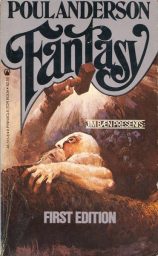 Fantasy (Ken Lizzi): In 1981, Poul Anderson put out a collection of selections of his fantasy short stories, titled plainly enough Fantasy. Though perhaps that’s misleading, as not every entry is a fantasy short story, some being essays, some humorous oddities, and some defying the reader to apply classification. But that, I believe, was intentional in order to spotlight the breadth of the subject matter.
Fantasy (Ken Lizzi): In 1981, Poul Anderson put out a collection of selections of his fantasy short stories, titled plainly enough Fantasy. Though perhaps that’s misleading, as not every entry is a fantasy short story, some being essays, some humorous oddities, and some defying the reader to apply classification. But that, I believe, was intentional in order to spotlight the breadth of the subject matter.
Is it any good?
Robert E. Howard (Sprague de Camp): The iron-bound book of Skelos,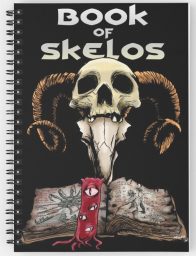 introduced in “The Pool of the Black One,” is one of the mystical books created by Robert E. Howard. Who was Skelos? What was in his book? How has it been portrayed in various REH-related media?
introduced in “The Pool of the Black One,” is one of the mystical books created by Robert E. Howard. Who was Skelos? What was in his book? How has it been portrayed in various REH-related media?
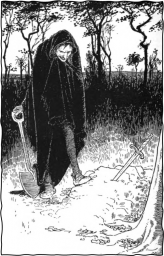 RPG (d4Caltrops): Certain magnificent Magics and marvelous Miracles make it possible to return a dead Character to Play in these games. In some games, this process is pretty perfunctory: Simply locate your Local Lama and acquire a casting of Raise Dead within the Time Limit. Then after a mandatory two-week recuperation period (during which the Character is hardly in a state for Adventure: with only a solitary Hit Point, half movement, no carrying capacity, they cannot attack, and are unable to use Spells or other Class Abilities) the revivified is right as rain.
RPG (d4Caltrops): Certain magnificent Magics and marvelous Miracles make it possible to return a dead Character to Play in these games. In some games, this process is pretty perfunctory: Simply locate your Local Lama and acquire a casting of Raise Dead within the Time Limit. Then after a mandatory two-week recuperation period (during which the Character is hardly in a state for Adventure: with only a solitary Hit Point, half movement, no carrying capacity, they cannot attack, and are unable to use Spells or other Class Abilities) the revivified is right as rain.
Fantasy (Skwishmi): This is a complete list of U.S. Editions of the BAF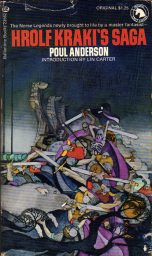 series. They are shown here alphabetically by author (or editor) – mostly. The list without photos and in chronological order is a little easier to digest. There were 80 titles in the series (or more, or less, depending on which collector you ask), printed between 1968 and 1974. Many rare and hard to find works (then and now) were included, some were published for the first and only time in this series, and of course the covers were created by some of the best fantasy artists of the day.
series. They are shown here alphabetically by author (or editor) – mostly. The list without photos and in chronological order is a little easier to digest. There were 80 titles in the series (or more, or less, depending on which collector you ask), printed between 1968 and 1974. Many rare and hard to find works (then and now) were included, some were published for the first and only time in this series, and of course the covers were created by some of the best fantasy artists of the day.
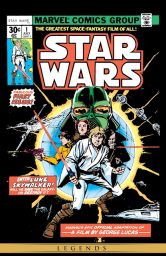 Star Wars (Universodecienciaficcion): In 1977, one of the most successful films was released in the history of the Cinema. Before the subtitle of Episode IV was given: A New Hope, she was known for a long time and all over the world, As simply, “Star Wars” (The War of the Galaxies in Spain). In One of his memorable scenes, Luke Skywalker enters the Star cell of Death in which Princess Leia is imprisoned and says to her: “I am Here to rescue you. Well, that phrase might well have been said George. Lucas to Marvel Comics.
Star Wars (Universodecienciaficcion): In 1977, one of the most successful films was released in the history of the Cinema. Before the subtitle of Episode IV was given: A New Hope, she was known for a long time and all over the world, As simply, “Star Wars” (The War of the Galaxies in Spain). In One of his memorable scenes, Luke Skywalker enters the Star cell of Death in which Princess Leia is imprisoned and says to her: “I am Here to rescue you. Well, that phrase might well have been said George. Lucas to Marvel Comics.
RPG (Grognardia): I could (and probably should) write several posts about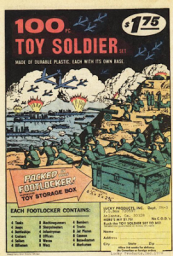 all the weird and wonderful stuff that was being hawked on the pages of comics in the 1970s, but the one that, to this day, still sticks in my brain, is the one to the right, offering 100 toy soldiers for a mere $1.75.
all the weird and wonderful stuff that was being hawked on the pages of comics in the 1970s, but the one that, to this day, still sticks in my brain, is the one to the right, offering 100 toy soldiers for a mere $1.75.
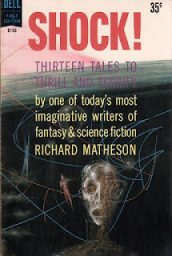 Science Fiction (M Porcius): Remember back in 2022 when we read Richard Matheson’s collection Shock 2 over the course of three blog posts (Un Deux Trois)? The last few days the first volume in the Shock series has come to mind–I saw a copy of an edition of it at an antiques store, and noticed “Lemmings” in the same issue of F&SF as a Mark Clifton story I read, “Remembrance and Reflection.”
Science Fiction (M Porcius): Remember back in 2022 when we read Richard Matheson’s collection Shock 2 over the course of three blog posts (Un Deux Trois)? The last few days the first volume in the Shock series has come to mind–I saw a copy of an edition of it at an antiques store, and noticed “Lemmings” in the same issue of F&SF as a Mark Clifton story I read, “Remembrance and Reflection.”
T.V. (Flash Back Universe): The television version of Have Gun – Will Travel

HAVE GUN-WILL TRAVEL, Richard Boone 1957-63
aired on CBS from 1957 to 1953. Interestingly, there was a radio version starring John Dehner as Paladin which debuted on November 23, 1958, making Have Gun – Will Travel of the few shows in television history to spawn a successful radio version, instead of the other way around.
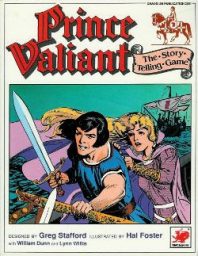 Games (Grognardia): It’s worth noting, too, that the bulk of Prince Valiant‘s 128-page rulebook is made up not of game mechanics but of advice and tools for players and storytellers alike. Stafford quite obviously distilled the lessons he learned from his many years of playing and refereeing roleplaying games, presenting them in a conversational, easy-to-understand way.
Games (Grognardia): It’s worth noting, too, that the bulk of Prince Valiant‘s 128-page rulebook is made up not of game mechanics but of advice and tools for players and storytellers alike. Stafford quite obviously distilled the lessons he learned from his many years of playing and refereeing roleplaying games, presenting them in a conversational, easy-to-understand way.
Pulp (Pulp.net): We now have the annual issue of Blood ‘n’ Thunder, the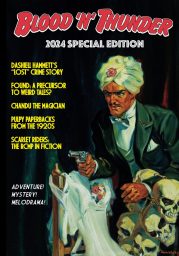 Blood ‘n’ Thunder 2024 Special Edition, from Murania Press, again a little before Windy City Pulp and Paper Convention. This one clocks in at 276 pages, a little shorter than last year’s, with 16 articles on pulp, vintage movies, and old-time radio. We get several top contributors this time, along with some first-timers.
Blood ‘n’ Thunder 2024 Special Edition, from Murania Press, again a little before Windy City Pulp and Paper Convention. This one clocks in at 276 pages, a little shorter than last year’s, with 16 articles on pulp, vintage movies, and old-time radio. We get several top contributors this time, along with some first-timers.
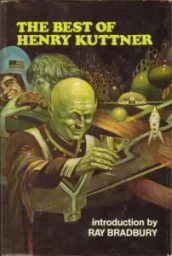 Science Fiction (Adventures Fantastic): Henry Kuttner (1915-1958) was born today, May 5. He’s been my favorite science fcition and fantasy writer ever since I read “Mimsy were the Borogoves” in The Best of Henry Kuttner the summer before I started high high school.
Science Fiction (Adventures Fantastic): Henry Kuttner (1915-1958) was born today, May 5. He’s been my favorite science fcition and fantasy writer ever since I read “Mimsy were the Borogoves” in The Best of Henry Kuttner the summer before I started high high school.
Comic Books (Fandom Pulse): Ben Dunn of Antarctic Press has been known for his parody creations for the comic company throughout the years with classic hits like “Steam Wars” and “Notzilla.” It came as no surprise for fans of the indie work that Ben Dunn was doing a Red Sonja parody book called Blue Sonya, which he hoped to release soon. However, Red Sonja, LLC took notice of the parody and threatened Antarctic Press, claiming trademark violations of the work.
for his parody creations for the comic company throughout the years with classic hits like “Steam Wars” and “Notzilla.” It came as no surprise for fans of the indie work that Ben Dunn was doing a Red Sonja parody book called Blue Sonya, which he hoped to release soon. However, Red Sonja, LLC took notice of the parody and threatened Antarctic Press, claiming trademark violations of the work.
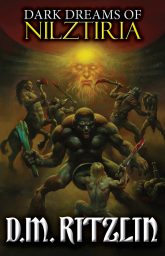 New (DMR Books): For the release of my new fantasy story collection Dark Dreams of Nilztiria, I wanted to do something special to celebrate it. Thanks to the fine folks at Bucket o’ Blood Books and Records, we’re going to have a release party! For nearly fifteen years Bucket o’ Blood has been the best bookstore in Chicago specializing in horror, fantasy, and science fiction.
New (DMR Books): For the release of my new fantasy story collection Dark Dreams of Nilztiria, I wanted to do something special to celebrate it. Thanks to the fine folks at Bucket o’ Blood Books and Records, we’re going to have a release party! For nearly fifteen years Bucket o’ Blood has been the best bookstore in Chicago specializing in horror, fantasy, and science fiction.
Warhammer (Lord Samper Library): ‘Day of Ascension’ is a lively read that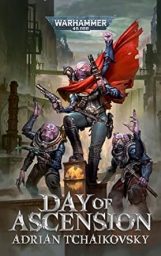 neatly sidesteps the big issue I was dreading by, funnily enough, really focusing on it and making it part of a very engaging wider discussion on the purpose of the Mechanicum and how this can sometimes go against itself in a battle between the human need to innovate and the ‘machine approach’ of achieving optimal operations and just maintaining that level forever.
neatly sidesteps the big issue I was dreading by, funnily enough, really focusing on it and making it part of a very engaging wider discussion on the purpose of the Mechanicum and how this can sometimes go against itself in a battle between the human need to innovate and the ‘machine approach’ of achieving optimal operations and just maintaining that level forever.
H. P. Lovecraft (Tentaclii): On ploughing through the Tolkien fan-journal Mallorn, from #53-64 (current) I discovered that January 1934 was the likely date when C.S. Lewis (the Narnia books, and he was also the midwife for The Lord of the Rings) started paying regular attention to American pulp magazines.
Interview (DMR Books): I’m Ville Meriläinen, a Finnish thirty-something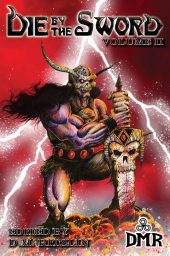 writer of fantasy and horror fiction. I started writing as a teenager hoping it would get me attention and kept writing through my twenties hoping it would make me money. Ah, to be that innocent again.
writer of fantasy and horror fiction. I started writing as a teenager hoping it would get me attention and kept writing through my twenties hoping it would make me money. Ah, to be that innocent again.
 Science Fiction (Reactormag): Back in the early 1970s, I decided to give the series a try, starting with Triplanetary, which I found in a bookstore with a nifty new cover by Jack Gaughan. I didn’t enjoy the book, and put it down partway through, in fact. But I recently ran into more of Smith’s work in some anthologies, and while it was very pulpy, I enjoyed its enthusiasm. I wondered if perhaps my tastes had changed, and decided to give Triplanetary another try.
Science Fiction (Reactormag): Back in the early 1970s, I decided to give the series a try, starting with Triplanetary, which I found in a bookstore with a nifty new cover by Jack Gaughan. I didn’t enjoy the book, and put it down partway through, in fact. But I recently ran into more of Smith’s work in some anthologies, and while it was very pulpy, I enjoyed its enthusiasm. I wondered if perhaps my tastes had changed, and decided to give Triplanetary another try.
Science Fiction (Poul Anderson Contributor Articles): In this essay I wish to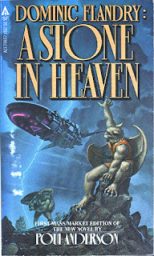 summarize, quote, and comment on what I found in some of the works of Poul Anderson on the issue of political legitimacy. One very important point to be found in his thought where it touches on politics is his insistence on the need for the state, any state, to be LEGITIMATE, for it to believe itself having the right to govern and for its people to also believe it is legitimate.
summarize, quote, and comment on what I found in some of the works of Poul Anderson on the issue of political legitimacy. One very important point to be found in his thought where it touches on politics is his insistence on the need for the state, any state, to be LEGITIMATE, for it to believe itself having the right to govern and for its people to also believe it is legitimate.
Science Fiction (Reactormag): A couple of weeks ago, while rummaging through old books, I came across my old copy of Citizen of the Galaxy. “That was a good one,” I thought. “Perfect for re-reading out in the backyard on a sunny summer day.” I’d first read it back when I was 12 or 13, but didn’t remember many details. It turned out that the book is both more preachy and a lot darker than I had remembered…which made me wonder why so many authors write books for juveniles and young adults that expose the protagonists to so much misery.
Science Fiction (Goodman Games): Not many authors can be credited with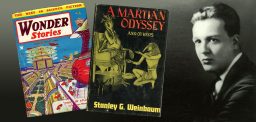 changing the entire trajectory of a genre, yet Stanley Grauman Weinbaum managed to do so with his very first published science fiction story A Martian Odyssey. The story first appeared in the July 1934 issue of the science fiction pulp magazine Wonder Stories, which was a distant third in popularity to Astounding Stories and Amazing Stories. Forty years later, no less a figure than Isaac Asimov would declare that “hidden in this obscure magazine, A Martian Odyssey had the effect on the field of an exploding grenade.
changing the entire trajectory of a genre, yet Stanley Grauman Weinbaum managed to do so with his very first published science fiction story A Martian Odyssey. The story first appeared in the July 1934 issue of the science fiction pulp magazine Wonder Stories, which was a distant third in popularity to Astounding Stories and Amazing Stories. Forty years later, no less a figure than Isaac Asimov would declare that “hidden in this obscure magazine, A Martian Odyssey had the effect on the field of an exploding grenade.
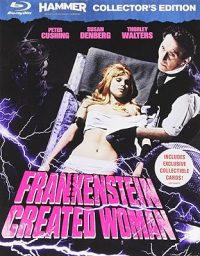 Cinema (Fantasy Literature): In 1957, Hammer Studios in England came out with the first of their full-color horror creations, The Curse of Frankenstein, starring Peter Cushing as the good doctor and Christopher Lee (for the first and only time) as The Monster. The film was such a hit that it not only spawned an entire Frankenstein series from the studio, but would also cause the producers there to begin on a Dracula series and a Mummy series, eventually leading to Hammer becoming one of the preeminent creators of Gothic horror in the 1960s and ‘70s.
Cinema (Fantasy Literature): In 1957, Hammer Studios in England came out with the first of their full-color horror creations, The Curse of Frankenstein, starring Peter Cushing as the good doctor and Christopher Lee (for the first and only time) as The Monster. The film was such a hit that it not only spawned an entire Frankenstein series from the studio, but would also cause the producers there to begin on a Dracula series and a Mummy series, eventually leading to Hammer becoming one of the preeminent creators of Gothic horror in the 1960s and ‘70s.
Science Fiction (Michael K. Vaughan): The Works of Richard Matheson.
Comic Books (Grim Dark Magazine): In Creepshow #3, we have two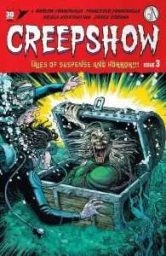 fetching stories that will linger long under your skin (that itch, as story one, Eternity, Eternity, Eternity, reveals, may be a race of long lived locusts). The motto of the opening story is ‘love was the carrot, and life was the stick’ and our nameless protagonist suffers the stick more than the carrot.
fetching stories that will linger long under your skin (that itch, as story one, Eternity, Eternity, Eternity, reveals, may be a race of long lived locusts). The motto of the opening story is ‘love was the carrot, and life was the stick’ and our nameless protagonist suffers the stick more than the carrot.
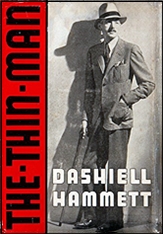 Mystery (Mystery File): DASHIELL HAMMETT – The Thin Man. Alfred A. Knopf, hardcover, 1934. Originally published in abridged form in Redbook (December 1933). Reprinted many times. Film: MGM, 1945, starring William Powell & Myrna Loy. (A total of six films were made based on the characters.) TV series: NBC, 1957-59, starring Peter Lawford & Phyllis Kirk.
Mystery (Mystery File): DASHIELL HAMMETT – The Thin Man. Alfred A. Knopf, hardcover, 1934. Originally published in abridged form in Redbook (December 1933). Reprinted many times. Film: MGM, 1945, starring William Powell & Myrna Loy. (A total of six films were made based on the characters.) TV series: NBC, 1957-59, starring Peter Lawford & Phyllis Kirk.
I’m going to have to do a follow-up on that lead link on the science fiction book market. It is a common misunderstanding of what a “market” is.